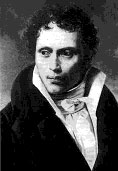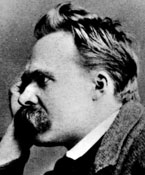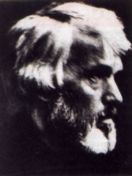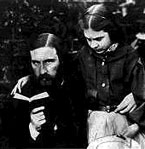This page looks at some of the major influences on David Lindsay’s work. Gary K Wolfe provides a useful list of some of the authors that made up Lindsay’s personal library:
We do know that he was fond of German metaphysics, the Norse sagas, historical works dealing with the Roman Empire, and personal memoirs of the eighteenth century... Of the authors that we know to have been represented in his library, those of particular interest include Goethe, Nietzsche, Schopenhauer, Emerson, Robert Louis Stevenson, Rider Haggard, and F Max Muller’s Three Lectures on Vedanta Philosophy...
— Gary K Wolfe, Starmont Reader’s Guide 9: David Lindsay, p. 11

Lindsay says: “Schopenhauer’s ‘Nothing’, which is the least understood part of his system, is identical with my Muspel [of A Voyage to Arcturus]; that is, the real world.”
Arthur Schopenhauer (1788—1860) was a German philosopher whose most famous work is The World as Will and Idea (1819). Among other things, it asserted that the body is the perceptible form of the will, which certainly influenced Arcturus in the way the protagonist Maskull gains and loses new limbs and sensory organs, one of which, the sorb, has the purpose of engulfing another living being by the force of one’s will.
Lindsay also took the word for his ideal state, the Sublime, from Schopenhauer, although their meaning differs, and, as the above quote makes clear, both Lindsay and Schopenhauer were interested in a “Nothing” state. For Schopenhauer, this was a calm, will-less state. Lindsay’s Muspel, the goal of Maskull’s quest, is referred to as “Nothing, which is still Something,” emphasising how widely his ideal state of existence differed from reality.

Lindsay makes several references to the German philosopher Freidrich Nietzsche (1844—1900) in his Philosophical Notes, the most revealing of which states: “Nietzsche was right in recommending men to live dangerously; though wrong in saying he should be a slave of his passions.”
Nietzsche is most famous as the man who proclaimed the death of God, and it is this attitude — the breaking down of old beliefs to separate truth from illusion — that finds its echo in Lindsay, who learned German in order to read both Nietzsche and Schopenhauer in the original.

E H Visiak says that Lindsay’s “kinsman, Carlyle — whom he facially resembled, and admired — achieved the faculty of writing as he spoke, and Lindsay tried eventually to imitate his style.”
Thomas Carlyle (1795—1881) was a historian, novelist and essayist who exerted a huge influence over the Victorian age. His major works are the satirical novel Sartor Resartus (1833-4), the history The French Revolution (1837), and the lecture-series On Heroes, Hero-Worship and the Heroic in History (1841).
Sartor Resartus is an attack on sham and pretence. Carlyle emphasised the values of work, duty and self-abnegation as a defence against the uncertainty of a changing age, and was engaged in a constant search for a heroic role model. Such themes all find echoes in the works of David Lindsay, except Lindsay was in no way concerned with society as a whole.

E H Visiak says, in The Strange Genius of David Lindsay: “The author who had most influenced him, he told me, was George MacDonald.”
MacDonald’s two adult fantasy novels, Phantastes (1858) and Lilith (1895), contain the same mix of fantasy adventure and moral/spiritual quest as Lindsay’s A Voyage to Arcturus.
Read more about MacDonald’s influence on Lindsay in this essay elsewhere on the site.

Chief among Lindsay’s musical loves were the works of Ludwig van Beethoven (1770—1827).
“Up to the present,” Lindsay said in his Philosophical Notes, “there is no Beethoven of literature.” If there is ever to be, then A Voyage to Arcturus is surely a contender as a Beethoven symphony in prose. At least one chapter (XIII, “Wombflash Forest”) was directly inspired by his music (in this case, the 5th Symphony). Lindsay also said: “Beethoven’s four Symphonies, 3, 5, 7 & 9, illustrate his passage from without to within. The 3rd is historical, the 5th autobiographical, the 7th sensational, the 9th psychical.”
As well as these, Lindsay especially enjoyed the Andante in F (which is played in The Violet Apple) and the Overture to Coriolanus. Beethoven’s Kreutzer Sonata is also played in The Violet Apple, although this may also be an oblique reference to Tolstoy’s story of the same name (which is about marital infidelity), something made more likely by the fact that the piece is played, in Lindsay’s novel, by a Russian count.
Beethoven makes a musical appearance in The Haunted Woman, when the American artist Sherrup plays the opening bars of the A major (7th) symphony, and explains: “Some ideas came to me in this house which seemed to require music to illustrate them — that particular music, I mean.”
